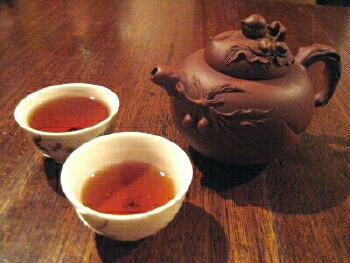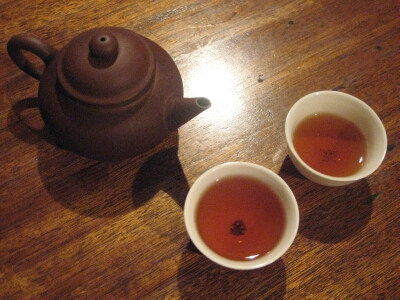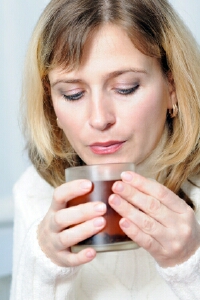 Pu-erh
definitely not poor (in value)
Pu-erh
definitely not poor (in value)
You can find much information on Pu-Erh (pronounced
poo-ur) by Googling
for "pu-erh" and most of the articles stress two attributes of this
tea: Detoxification and lowering of blood cholesterol, and at
least one article which mentions about 'maintaining the elasticity' of
blood vessels thus preventing artherosclerosis and arteriosclerosis.
Pu-erh is basically a
probiotic-prebiotic, which means it is a natural phyto-material
substance which allows friendly bacteria to proliferate on it. Pu-Erh
is a process of fermenting the tea to have the certain
type of friendly bacteria and thus the certain type of taste. In fact
there could be at least one fungus which grows on Pu-Erh tea leaves.
One species is
given the Mandarin name Qing
Hua (Golden Flower or Fungus).
About the heresy regarding the
caffeine in tea, the fact is that from the way tea is brewed it is
always easy to discard the first brew and that takes away almost at
least 50% of the caffeine content. Moreover,
caffeine in tea leaves is not as high as from the coffee nut.
Yet it is indeed strange that very little mention is made on what makes
this 'fermented' tea give a
rich
golden color to an infusion of its
leaves.
Pu-erh is definitely a product of fermentation, slow or
rapid. As with all fermentation processes, bacterial and
fungal action have to be involved, whether induced or natural.
Understanding the role of fermentation in Pu-erh is important
(though most people tend to ignore this) because it will suddenly make
you realise that Pu-erh is actually somewhat a probiotic.
Definitely, there exists some form of friendly microbe on the
surface
and inside of the
Camellia
Sinensis leaves which are used to make Pu-erh.
 Pu-erh
tea is actually about probiotics
Pu-erh
tea is actually about probiotics
Your perspective of Pu-erh tea will drastically change when you
understand that the potential 'actions' of detoxification and the
healthy maintenance of blood in our bodies by imbibing Pu-erh
tea are not coming only from the tea leaves per se, but from a
microcosm of
prebiotics (the
tea leaves, fibrous material, and other
concomitants) and
probiotics (the bacteria and fungi which have made a
'home' in the tea leaves. Some knowledgeable tea-drinkers
will tell you that a certain class of fungi 'residing' on the Pu-Erh
tea gives the golden hue to an infusion of the leaves; and thus they
called it
Qing Hua
(Mandarin, Golden Flower) or
Kum
Mou (Cantonese, Golden Fungus).
In fact, the
Kombucha
fungus can actually be 'grown' out of an infusion of Pu-erh tea, though
this 'farming' has to be carried out with stringent conditions of
cleanliness in
utensils and environment. Having said this, is it any wonder
why Pu-erh has special attributes which cannot be rivalled by
non-fermented tea. It cannot be the tea leaves but the good
fermenation that is going on in the tea leaves which make Pu-erh a
prized collection.
Once you appreciate the 'fermentation' in
Pu-erh, you will begin to relate Pu-erh with other types of good
fermentation by friendly bacteria and fungi and even from myco-bacteria
(such as Tibicos, Kombucha). There are already many forms of
good
fermentated foods which are part and parcel of a healthy diet (though
this is not recommended by mainstream medical science) such as yogurt,
kefir, soya-sauce, chutneys, fruit enzymes, milk-kefir, sugar-water
enzymes, coconut water enzymes, etc.
In other words, the beneficial constituents of the Camellia
Sinensis tea leaves cannot be the sole category of 'actives' which make
Pu-erh special, and yet most scientific analysis on Pu-erh (or any
other tea for that matter) focusses on the chemical constituents of the
tea leaves. Why? Simply because from where
mainstream
medical science derives its premises, principles and
fundamentals, it is impossible for the practitioners in
mainstream
medical science to look beyond the tunnel vision which their
very
education had designed them to be.
Anyway, never mind how the 'modernists'
pooh-pooh at the 'ancient'
Chinese tea. After all, you don't owe them your life and
neither
do they. Better take care of your life with something with at
least 2,000 years history.
 Pu-erh much sought after in the
West now
Pu-erh much sought after in the
West now
Pu−erh, the unique tea from Yunnan, China is picking up momentums in
oversea tea market. It was listed under the same category as black tea
by many oversea tea vendors few years ago. More and more oversea tea
vendors are now listing it as a distinctive category by itself. More
and more foreigners come to Yunnan in searching for answers to this
mystery tea.
Researchers around the world have been interested in the health
benefits of Pu−erh. Various researches conducted in countries like
Japan and France shows that Pu−erh has the effects of lowering
cholesterol, lowering blood fat, lowering blood pressure, lowering
weight, etc. Pu−erh has been called "Beauty Tea", "Slim Tea", and
"Longevity Tea" in countries like Japan,
Korea, Germany, Italy, and France.
Comparing to other teas, Pu−erh has more complicated tastes. This may
largely be due to the fact that Pu−erh has some life forms, i.e.
friendly microbes. Just like all
fermented edible foods,
the taste of a Pu−erh develops slowly with aging. And any change in
its storage environment can change the path of the development; and
that means the wrong storage conditions will destroy the quality of the
Pu-erh.
Pu−erh
is one of the 10 famous teas in China. High quality Pu−erh demands a
premium price in China, and barely makes its way to oversea market. Low
quality Pu−erh that makes to oversea massive tea market painted a
damaging image of Pu−erh. Most of those low quality Pu−erh have poor
tastes, or simply undrinkable. Luckily, with the increasing
globalization, many overseas tea drinkers start to have access to
higher
quality Pu−erh, and realize the wonders of Pu−erh.
(Source:
http://www.cyber-spy.com/ebooks/ebooks/Puerh-Tea-is-IN-%28ebook%29.pdf)
 Pu-erh
definitely not poor (in value)
Pu-erh
definitely not poor (in value) 

